Mel Blanc would be 110 on Wednesday, so here’s a “Spin” focusing on a little-discussed member of his “stable” who he performed longer on records than in films.
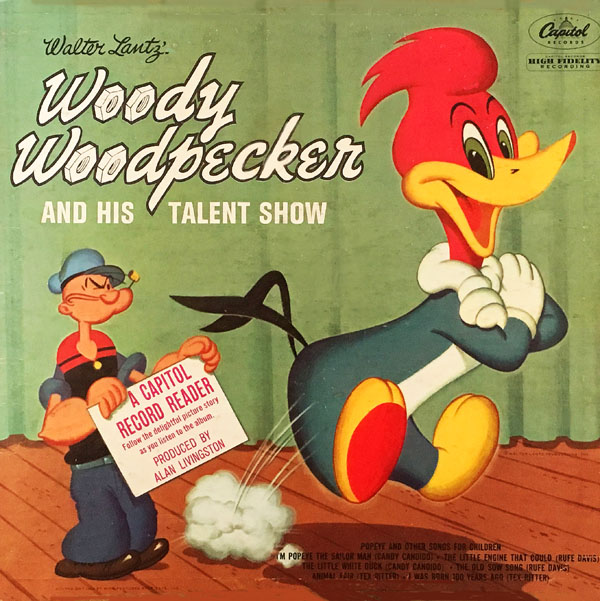
Walter Lantz’s
WOODY WOODPECKER AND HIS TALENT SHOW
Capitol Records Record Reader Series DBX-3032 (2 Discs 10” 78 RPM & 45 RPM)
Capitol LP Reissue JAO-3251 (1961) (With Popeye & Other Songs for Children)
Capitol/Wonderland/Ziv LP Reissue L-6989 (1975) (With Bozo Has a Party)
Released in 1949. Producer: Alan W. Livingston. Writers: Tedd Pierce, Alan Livingston. Music: Billy May. Running Time: 12 minutes.
Performers: Mel Blanc (Woody Woodpecker, Stanley Squirrel, Billy Goat, Plato Platypus, Fido, Happy Hedgehog, Harry Humbug); June Foray (Thomasina Cat).
Tunes & Melodies: “Platypus Song,” “What Kind of Wood Would a Woodpecker Peck” by Tedd Pierce, Alan Livingston, Billy May; “O Sole Mio” by Giovanni Capurro, Eduardo di Capua, Alfredo Mazzucchi; “Blue Danube Waltz” by Johann Strauss II; “Aloha ‘Oe” by Princess Liliʻuokalani; “How Dry I Am,” “Mary Had a Little Lamb” (Traditional).
Woody Woodpecker was Mel Blanc’s first character voice. He didn’t know it at the time, but as teen, running up and down the halls of Lincoln High School in Portland, Oregon, going “Ha-ha-ha-HAAAA-haaa!” he was sowing superstar birdseed.
Decades later, in a lengthy Bugs Bunny section of his autobiography, That’s Not All, Folks!, Blanc explains how the wascally wabbit evolved both visually and vocally. “By the time of A Wild Hare (1940), which is considered Bugs Bunny’s debut, he’d obviously had some work done… he was a sly-looking rascal… and the boisterous laugh I’d originally given him would no longer fit. It was redeposited in my memory bank, to be withdrawn several years later for another Ben Hardaway creation: Woody Woodpecker.”
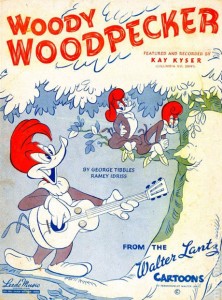 Blanc’s contract with Warner did not prevent him from voicing Woody anywhere but in films. Ben Hardaway himself–in addition to a few others–did Woody’s slightly sped-up voice before Grace Stafford Lantz assumed the role until her passing).
Blanc’s contract with Warner did not prevent him from voicing Woody anywhere but in films. Ben Hardaway himself–in addition to a few others–did Woody’s slightly sped-up voice before Grace Stafford Lantz assumed the role until her passing).
Blanc kept playing Woody on radio and records until 1955. In addition to his version of “The Woody Woodpecker Song” (which was an even bigger hit for bandleader Kay Kyser with featured soloist Gloria Wood, who told and sang Disney’s marvelous Christmas Adventure in Disneyland), Blanc’s prolific association with Capitol Records yielded two double-disc albums and eight single records featuring Woody, in addition to his many Looney Tunes-related recordings for the label.
The two albums featured in today’s Spin are the only ones that were released as LP records, which is a shame because the singles are also very entertaining and could have been compiled into at least one six-story album like Capitol’s Bugs Bunny and His Friends.
Woody Woodpecker and His Talent Show could easily have been done as “Bozo and His Talent Show”, since there is no special reason for Woody to be there except to sing about his fondness for wood. Bozo or any other character could just as easily have introduced each “talent show performer.” Like the Bozo records and some of the Looney Tunes discs, the format is a “meet-and-greet” revue in which each character appears to say something funny, sing or play a short musical piece. The oft-returning billy goat serves as a through line to make the story hold together, more or less. The Capitol records series is so delightful, it’s easy to overlook this repetitive format because it is presented so well with legendary voice actors and lavish music. This was top-notch recorded magic for kids and they were designed to be played over and over again.
“Woody Woodpecker’s Talent Show”
This album was called a “record-reader,” with a gatefold cover containing small pictures (a “storyboard” as it were) that the listener could look at in sequence as Woody’s laugh told them to go from one to another. The person who made this video made the pictures change in sync with the recording.
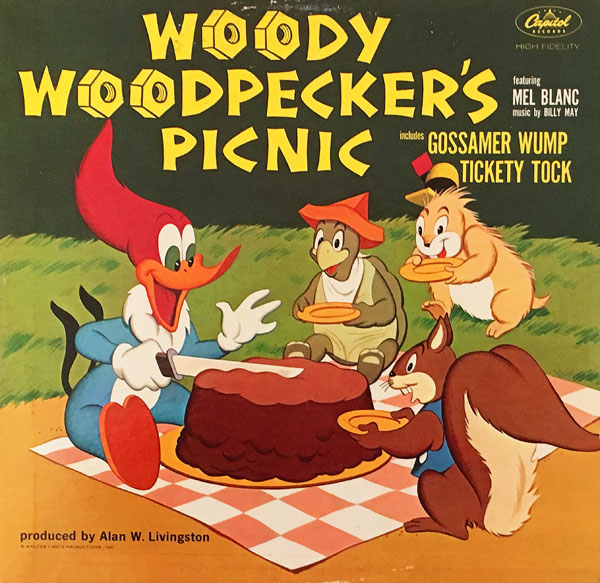
Walter Lantz’s
WOODY WOODPECKER’S PICNIC
Capitol Records Record Reader Series DBS-3091 (2 Discs 10” 78 RPM & 45 RPM)
Capitol LP Reissue JAO-3251 (1961) (with Gossamer Wump & Tickety Tock)
Capitol/Wonderland/Ziv LP Reissue L-6989 (1975) (with Sparky and the Talking Train)
Released in 1951. Producer: Alan W. Livingston. Writer: Tedd Pierce. Music: Billy May. Running Time: 13 minutes.
Performers: Mel Blanc (Woody Woodpecker, Tommy Turtle, English Bulldog, German Shepherd, Irish Setter, Scotty); June Foray (Sammy Squirrel, French Poodle).
Tunes & Melodies: “What Would I Do Without Wood?” “Woody Woodpecker Polka,” Ants March #1; Ants March #2; by Tedd Pierce, Billy May.
The second of the two-disc Woody Woodpecker Capitol record albums, this has more of a story line than Talent Show. Even though Woody still has a “meet-and-greet” with several animal friends who tell jokes and sing little tunes, there is a fun story line about ants attacking a big chocolate cake that gives this album a stronger overall script than the first album.
GIVE A LITTLE LISTEN
“Woody Woodpecker’s Picnic”
This was not a record-reader title like Talent Show, but was a two-disc set later released on one side of a LP album.
Though Mel Blanc and Walter Lantz were friends and remained so, Blanc found it unfair that Lantz continued to use the trademark Woody laugh in subsequent cartoons, even though he was no longer doing the voice. Lantz believed every aspect of Woody was his property. Blanc took Lantz to court a year before all of these records were made.
“Mel lost the suit,” wrote Ben Ohmart in Mel Blanc, Man of A Thousand Voices. “Superior Judge Daniel J. Stevens ruling that since Mel had failed to copyright his musical crescendo, his exclusive right under common law gave him title only for the original publication.”
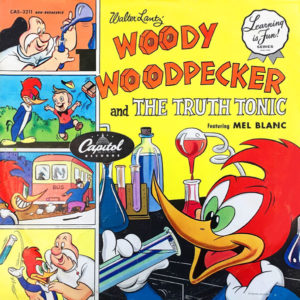 As Joe Adamson explained in The Walter Lantz Story, the judge decided that the laugh was public domain unless Blanc had copyrighted sometime in his life. The book quotes Blanc: “Yeah, but who copyrights a laugh?” The case became the focus of much legal debate.
As Joe Adamson explained in The Walter Lantz Story, the judge decided that the laugh was public domain unless Blanc had copyrighted sometime in his life. The book quotes Blanc: “Yeah, but who copyrights a laugh?” The case became the focus of much legal debate.
“When Lantz heard that Blanc and his attorneys were taking the decision to the California Court of Appeals, he contacted the voice actor and made an out-of-court settlement that apparently satisfied both sides,” wrote Adamson, who adds another quote from Mel Blanc: “Walter’s a nice guy.”
This sort of thing was never easy for Blanc, however. As Ohmart concluded: “It was a hollow victory for Mel, since even Warner Bros. continued to do whatever they liked with the recordings they owned and paid for. Until the 1960s when he renegotiated his contract, Mel made barely $20,000 a year from Warner Brothers cartoons. Most of his earnings came from radio and TV work.”
In describing the Capitol Woody Woodpecker singles in his autobiography, Blanc ends on a telling note, describing one record in particular to reflect his own feelings on the compensation issue.
“Other Woody 45s and 78s combined music with children’s stories and morals,” Blanc wrote. “For instance, 1952’s Woody Woodpecker and His Spaceship, in which Woody blasts off into outer space. His rocket comes to rest in ‘Double Land,’ the inhabitants of which possess two heads, speak in double-talk, and drink double-chocolate malts. However, not everything in Double-Land is idyllic. They have to wash two faces. If only the sales royalties had been based on a similar mathematical principle.”
Woody Woodpecker and His Space Ship
These are the other single-disc Capitol Woody Woodpecker records:
Woody Woodpecker and the Scarecrow (1952)
Woody Woodpecker and the Lost Monkey (1953)
Woody Woodpecker and the Animal Crackers (1953)
Woody Woodpecker and the Truth Tonic (1954)
Woody Woodpecker Meets Davy Crockett (1955)
Woody Woodpecker’s Fairy Godmother (1955)
Woody Woodpecker in Mixed-Up Land (1955, no audio available)
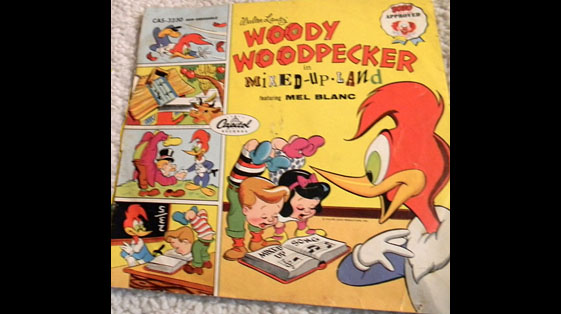


 GREG EHRBAR is a freelance writer/producer for television, advertising, books, theme parks and stage. Greg has worked on content for such studios as Disney, Warner and Universal, with some of Hollywood’s biggest stars. His numerous books include Mouse Tracks: The Story of Walt Disney Records (with Tim Hollis). Visit
GREG EHRBAR is a freelance writer/producer for television, advertising, books, theme parks and stage. Greg has worked on content for such studios as Disney, Warner and Universal, with some of Hollywood’s biggest stars. His numerous books include Mouse Tracks: The Story of Walt Disney Records (with Tim Hollis). Visit 





















































Well, it’s really Bugs Bunny sped up a little.
This is a fascinating post and, wow, Mel Blanc sure did enough of these types of recordings to warrant a box set around just about all the stuff he’s done like this, whether as Woody Woodpecker, Bugs Bunny, Daffy Duck, Tweety Pie…or even those otehr musical moments in cartoons in which he took part, and some of those come from all the animation studios. He did this amazing amount of cartoon voice over work, and some of those include production numbers. Sure would be a fun idea!
In the early 50s, there was a running gag on Jack Benny’s radio show in which Jack would keep encountering a real-life film executive (I think it was Hal Wallis) who would only reply in the Woody Woodpecker laugh, performed by Mel Blanc of course. One has to wonder if Mel was trying to reclaim his creation by shifting it to a different character.
The character attributed to the Woody laugh running gag on the Jack Benny Program was Norman Krasna, not Hal Wallis.
Thanks for correcting that. Didn’t have time to search dozens of episodes I heard a few years back.
Mel’s Woody Woodpecker voice is similar to his Porky Pig voice without the stuttering. What’s most important is that he’s quite convincing in the role, and even though it’s not the Woody voice from the movies, Mel manages to make the character his own. As narrator, he displays enthusiasm and affection for the character, and as Woody he absolutely shines.
It’s fun to hear June Foray as the Fairy Godmother. I also noted that she has a cameo as the school child on the “Truth Tonic” story. Note that both Daws Butler and Billy Bletcher are heard on the “Davy Crockett” story.
I know I’ve mentioned this before, but if you listen to a real woodpecker’s song it’s remarkably similar to Woody’s laugh.
What is Popeye doing on the cover of the Talent Show album?
–What is Popeye doing on the cover of the Talent Show album?–
The WOODY WOODPECKER’S TALENT SHOW album cover shown is for a 12-inch reissue from 1961, catalog number JAO-3251. Side one of that album has TALENT SHOW. Side two contains six children’s songs drawn from Capitol’s back catalogue. They are “I’m Popeye the Sailor Man” (Candy Candido), “The Little Engine That Could” (Rufe Davis), “The Little White Duck” (Candy Candido), “The Old Sow Song” (Rufe Davis), “Animal Fair” (Tex Ritter), and “I Was Born a Hundred Years Ago” (Tex Ritter). This reissue has a gatefold cover that reprints the original “record reader” artwork on the interior covers.
At Capitol Records in the early 90s, exploration was being done on the possibility of starting a reissue program drawn from the company’s children’s catalog. Unfortunately, there was a regime change in catalog development, and the first that happens in that circumstance is that the previous regime’s projects tend to get cancelled.
Side two of the album contains songs by Tex Ritter, Rufe Davis and the Popeye song by Candy Candido:
https://youtu.be/Qc1FeBN2Nf0
“What’s most important is that he’s quite convincing in the role, and even though it’s not the Woody voice from the movies, Mel manages to make the character his own. As narrator, he displays enthusiasm and affection for the character, and as Woody he absolutely shines.”
I’m not surpriced at all by that, since Blanc was the ORIGINAL Woody from the movies. I find Blanc and others who did Woody’s voice in the 40s vastly better than Grace Stafford.
Great article, Greg!
Thanks, Ben, and everyone else who provides such nice comments. They are really appreciated!
These Woodpecker Singles were so much fun to hear, Greg! Thanks! Were the story credits for the singles all Tedd Pierce? Did Billy May composel the songs? They all had a lively, cartoony quality that suited Woody and Mel Blanc’s delivery very well. I spotted Daws Butler doing the voice of Davy Crockett, making the record sound like a Lantz soundtrack of the 1960s. Billy Bletcher does the voice of the Indian Chief in the same record. Who does the voice of Wally Walrus? I can’t tell if it’s the same actor as the Wally of the cartoon; he has the personality and Swedish accent down pat. These are kind of hard Capitols to find, The only one I’ve ever located was “The Lost Monkey”, maybe “Mixed-Up Land” will show up someday. These are very similar to “Backwards Land” in the Daffy Duck Capitol record: “Daffy Duck Flies South”. Maybe that one was written by Tedd Pierce as well.
–What is Popeye doing on the cover of the Talent Show album?–
The WOODY WOODPECKER’S TALENT SHOW album cover shown is for a 12-inch reissue from 1961, catalog number JAO-3251. Side one of that album has TALENT SHOW. Side two contains six children’s songs drawn from Capitol’s back catalogue. They are “I’m Popeye the Sailor Man” (Candy Candido), “The Little Engine That Could” (Rufe Davis), “The Little White Duck” (Candy Candido), “The Old Sow Song” (Rufe Davis), “Animal Fair” (Tex Ritter), and “I Was Born a Hundred Years Ago” (Tex Ritter). This reissue has a gatefold cover that reprints the original “record reader” artwork on the interior covers.
At Capitol Records in the early 90s, exploration was being done on the possibility of starting a reissue program drawn from the company’s children’s catalog. Unfortunately, there was a regime change in catalog development, and the first that happens in that circumstance is that the previous regime’s projects tend to get cancelled.
It’s frankly too bad that Blanc had to relinquish Woody’s voice due to the rise of Bugs Bunny; he’s still the best as the zany character.
“My name? Oh that’s easy. My name’s Woody Murgatroyd Francis O’Leary Benvenuti Ifriham Hotchkiss George Woodpecker!”
Now we know.
The early ’90s were indeed a “golden” era for vault reissues. After Sony got impressive sales and kudos for their Complete Robert Johnson box, dollar signs appeared in the eyes of record execs. Capitol was mining material overseen by Ron Furmanek. Capitol’s Collectors and EMI Legendary Masters included vault finds,original mono masters,alternate takes,studio chatter,commercials or other goodies were included in each title,along with informative liner notes. Do not hesitate to pick up one of these titles,even if you aren’t a fan of the artist. Who knew Grand Funk Railroad could be so entertaining? The first CD era comp of Stan Freberg’s Capitol material is just one great example(BTW,Collectables reissued the Stan CD,along with some others in the series,so they aren’t always priced out of reach.) The Mel Blanc material would have been the next obvious project. This,while Border stores were placing kiddie vault material in their children’s sections to entice boomers and their kids to buy these kinds of titles for the kids of the ’90s. Sad,at the same time Rhino Records,doing similar work,changed distribution from EMI to WEA(Warner Bros.,Elektra Atlantic). With EMI,projects involving EMI-owned vault material were easier to put together(Rhino had a soft spot for surf music from Jan & Dean,the Beach Boys and the more obscure of this genre). When Rhino went over to WEA,they were first in charge of Atlantic’s vault,and eventually everything else. No time or money to dive into Mel Blanc’s non-Warner stuff over at EMI.
Today,that market is closed. No stores,no thirst for vault goodies,those kids of the ’90s,now parents,only know of the goodies bought for them. Amazon & lack of thirst for physical product hurts this area. While Shout! Factory(started by the original Rhino guys) does some interesting film/video projects,their audio end is pretty dormant. Sad.
I remember having a Woody Woodpecker in Double Double Land Land but maybe i am mistaken and it was this one. Certainly it had a song that i taught to my children in the car. It was on the lines of
Two two heads heads are are better better than than one-one any any day day. Its its an an old old saying. Saying you’ve you’ve heard heard many many say say. We we sing song to to gether gether which which you you cannot cannot do do…..etc etc